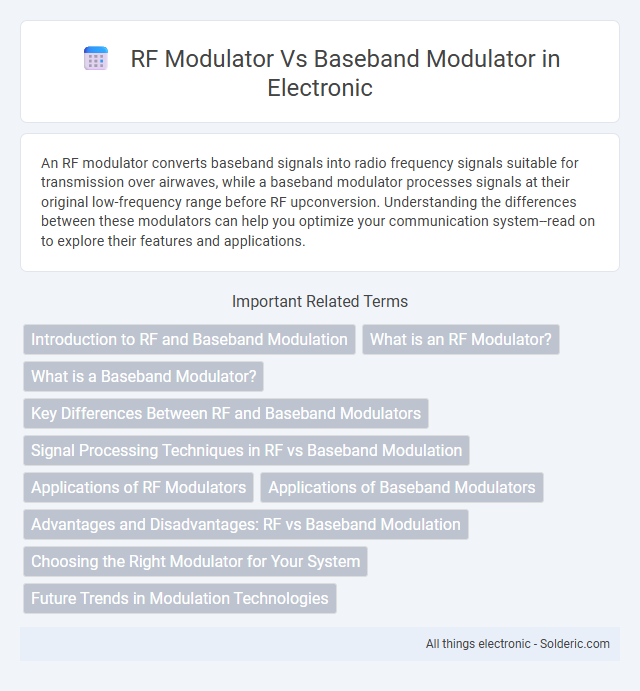An RF modulator converts baseband signals into radio frequency signals suitable for transmission over airwaves, while a baseband modulator processes signals at their original low-frequency range before RF upconversion. Understanding the differences between these modulators can help you optimize your communication system--read on to explore their features and applications.
Comparison Table
| Feature | RF Modulator | Baseband Modulator |
|---|---|---|
| Function | Converts baseband signals to RF signals for transmission | Processes baseband signals including digital or analog modulation |
| Output Signal | High-frequency radio frequency (RF) signal | Low-frequency baseband signal |
| Application | TV broadcasting, RF communication systems | Digital communication, signal processing |
| Complexity | Higher due to RF components and filtering | Lower, often digital and implemented in DSP |
| Frequency Range | Typically MHz to GHz range | Hz to kHz or low MHz range |
| Signal Processing | Involves upconversion and RF amplification | Involves modulation schemes like QAM, PSK at baseband |
| Examples | RF modulators for cable TV, analog RF transmitters | QAM baseband modulators, digital baseband processors |
Introduction to RF and Baseband Modulation
RF modulators convert baseband signals into radio frequency signals suitable for wireless transmission or broadcast, enabling communication across different frequency bands. Baseband modulators process signals at their original frequency range, often preparing audio, video, or data for further modulation or transmission. Understanding the distinction between these modulation types helps optimize your system design for signal compatibility and transmission efficiency.
What is an RF Modulator?
An RF modulator converts baseband signals, such as audio and video from devices like DVD players or gaming consoles, into radio frequency signals suitable for transmission over coaxial cables to televisions. It modulates information onto a carrier wave by varying frequency or amplitude, enabling compatibility with broadcast tuners. This process allows legacy analog TVs to receive and decode signals from modern digital sources without requiring specialized inputs.
What is a Baseband Modulator?
A baseband modulator processes signals at their original low-frequency form before transmission or further modulation stages. Unlike RF modulators that convert signals to high-frequency radio bands, baseband modulators manipulate the raw data or audio frequencies for applications like TV composite signals or digital communication systems. This fundamental modulation step is crucial for preparing signals for encoding methods such as amplitude or frequency shift keying.
Key Differences Between RF and Baseband Modulators
RF modulators convert baseband signals into radio frequency signals for transmission over airwaves or cables, while baseband modulators process signals directly at their original frequency range without upconversion. RF modulators are essential for wireless communication and broadcasting, enabling the signal to travel longer distances and be received by standard RF equipment. Your choice depends on application needs: use RF modulators for transmission and compatibility with RF systems, and baseband modulators for signal processing and short-range communication.
Signal Processing Techniques in RF vs Baseband Modulation
RF modulators convert baseband signals into high-frequency RF signals using upconversion and filtering techniques, enabling transmission over wireless channels with carrier frequency alignment. Baseband modulators operate directly on low-frequency signals through digital or analog processing methods such as pulse shaping, filtering, and symbol mapping to prepare data for RF upconversion or transmission over cable systems. Your choice between RF and baseband modulation impacts system complexity, spectral efficiency, and the suitability for specific communication environments.
Applications of RF Modulators
RF modulators are widely used in broadcasting and consumer electronics to convert baseband signals into radio frequency signals suitable for transmission over coaxial cables to televisions and other RF receivers. Common applications include cable TV systems, video game consoles, and VCRs, where compatibility with existing RF input interfaces is critical. Their ability to modulate audio and video signals onto carrier frequencies enables seamless integration with legacy RF infrastructure and devices.
Applications of Baseband Modulators
Baseband modulators are essential in digital communication systems, enabling efficient transmission of data over wired and wireless channels by converting baseband signals into modulated formats like QAM or PSK. These modulators are widely used in applications such as software-defined radios, digital television broadcasting, and Ethernet communication, where precise control of signal bandwidth and spectral efficiency is critical. Their ability to support high data rates and complex modulation schemes makes them ideal for modern communication networks and signal processing technologies.
Advantages and Disadvantages: RF vs Baseband Modulation
RF modulators enable wireless signal transmission over long distances and compatibility with various communication standards, but they introduce higher power consumption, complexity, and potential interference. Baseband modulators offer simpler implementation and lower power requirements for short-range or wired communication systems but lack the capability to efficiently propagate signals through RF channels. The choice between RF and baseband modulation depends on system requirements such as range, bandwidth, power efficiency, and susceptibility to noise.
Choosing the Right Modulator for Your System
Selecting the right modulator depends on system requirements such as frequency range, signal type, and transmission medium. RF modulators are ideal for broadcasting over RF channels, enabling compatibility with traditional antennas and TV tuners, while baseband modulators are suited for direct digital signal processing and short-range, high-fidelity applications. Evaluating factors like bandwidth, interference susceptibility, and device integration helps optimize performance and ensure seamless system operation.
Future Trends in Modulation Technologies
Future trends in modulation technologies emphasize the shift from traditional RF modulators towards advanced baseband modulators integrated with digital signal processing (DSP) for enhanced spectral efficiency and lower power consumption. Emerging 5G and beyond communication standards drive the need for sophisticated modulation schemes such as OFDM and QAM at the baseband level, enabling higher data rates and improved error correction. Innovations in software-defined radio (SDR) further enable flexible and adaptive modulation techniques that dynamically optimize signal quality across varying channel conditions.
RF modulator vs baseband modulator Infographic

 solderic.com
solderic.com